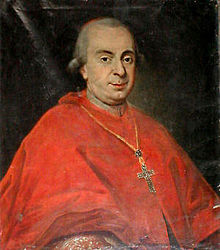Bernardino Honorati
Bernardino Honorati | |
|---|---|
 | |
| Born | July 17, 1724 |
| Died | August 12, 1807 (aged 83) Senigallia, Papal States |
| Occupation | Cardinal |
Bernardino Honorati (1724–1807) was an Italian Catholic bishop and cardinal.
Biography
Bernardino Honorati was born in Iesi on July 17, 1724, the son of Marquis Giuseppe Honorati, a patrician from Iesi, and Marianna Cima, a noblewoman from Rimini.[1]
He was educated at Rome.[1] In February 1744, he delivered an oration before Pope Benedict XIV and the College of Cardinals upon the occasion of the Feast of the Chair of Saint Peter; this oration was later published.[1] During this period, he served as a consistorial advocate, and then spent four years as secretary of the Dean of the Roman Rota.[1] He entered the papal household on December 23, 1746, becoming a chamberlain of honor.[1] In 1747, he served as a papal legate to take the red hat to the new Cardinal de Soubise.[1] He received a doctorate of both laws from the Sapienza University of Rome on February 10, 1749.[1]
On July 10, 1749, he was appointed Referendary of the Apostolic Signatura.[1] He became relator of the Sacred Congregation of Good Government on November 26, 1750.[1] He served as vice-legate of Romagna from January 13, 1755, to October 1756.[1] In September 1756, he was named relator of the Sacred Consulta, taking possession of the office upon his return to Rome.[1] He then served as governor of Loreto from January 28, 1758, until December 19, 1759.[1]
He was ordained as a priest on December 31, 1759.[1] On January 28, 1760, he was elected titular archbishop of Side; he was consecrated as a bishop by Giovanni Antonio Bacchettoni, Bishop of Locato and Recanati.[1]
On April 24, 1760, Pope Clement XIII made Honorati Apostolic Nuncio to Florence.[1] On November 20, 1766, he became nuncio in Venice.[1] He returned to Rome after he was appointed secretary of the Secretary of the Sacred Congregation of Bishops and Regulars on September 1, 1775.[1]
In the consistory of June 23, 1777, Pope Pius VI named him a cardinal, and he received the red hat on June 26, 1777, and the titular church of Santi Marcellino e Pietro al Laterano on July 28, 1777.[1]
He was translated to the See of Senigallia on July 28, 1777, but was allowed to retain the title of archbishop.[1] He celebrated a diocesan synod in May 1791.[1]
He participated in the papal conclave of 1799–1800 that elected Pope Pius VII.[1]
He died in Senigallia on August 12, 1807.[1]
